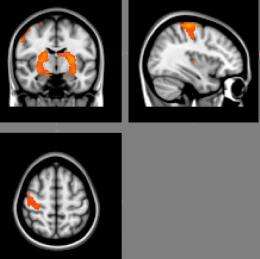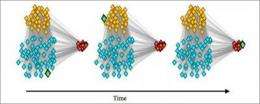Predicting learning using brain analysis

(PhysOrg.com) -- An international team of scientists has developed a way to predict how much a person can learn, based on studies at UC Santa Barbara's Brain Imaging Center.
A study published in this week's Proceedings of the National Academy of Sciences (PNAS) details the findings.
Researchers collected brain imaging data from people performing a motor task and then analyzed this data using new computational techniques. They found evidence that the flexibility of a person's brain can be used to predict how well someone will learn. The researchers view flexibility as how different areas of the brain link up in different combinations.
"What we wanted to do was find a way to predict how much someone is going to learn in the future, independent of how they are as a performer," said Scott T. Grafton, senior author and professor of psychology at UC Santa Barbara. Grafton is also director of the UCSB Brain Imaging Center.
The team ran an experiment over three sessions in which 18 volunteers had to push a series of buttons, similar to a sequence of notes on a piano keyboard, as fast as possible. They then divided functional MRI images of each volunteer's brain into 112 different regions and analyzed how these different areas connected while they performed the task.
"Our study has obvious implications clinically," said Grafton. "If you're a patient in physical therapy, should you just take tomorrow off? Or will it be a good day? We don't know that, but that would be a potential application — tailoring intervention to capacity to change. In healthy people, this information could accelerate learning — when you should study, when you should practice, when you should try to acquire a new skill."

The new study uses computational methods developed to analyze what the researchers call multilayer networks, in which each layer might represent a network at one snapshot in time, or a different set of connections between the same set of brain regions. These layers are combined into a larger mathematical object, which can contain a potentially huge amount of data and is difficult to analyze. Previous methods could only deal with each layer separately.
"Parts of the brain communicate with one another very strongly, so they form a sort of module of intercommunicating regions of the brain," said first author Danielle S. Bassett, postdoctoral fellow in physics at UC Santa Barbara. "In this way, brain activity can segregate into multiple functional modules. What we wanted to measure is how fluid those modules are."
Bassett explained that there are flexible brain regions with allegiances that change through time. "That flexibility seems to be the factor that predicts learning," said Bassett. "So, if you are very flexible, then you will end up learning better on the second day, and if you are not very flexible, then you learn less."
Bassett's education is highly interdisciplinary, with studies in physics, mathematics, psychology, and neuroscience. She received her Ph.D. in physics at the University of Cambridge where she had supervisors in several disciplines, including psychiatry. Her current studies are carried out within UC Santa Barbara's Department of Physics and Department of Psychology.
More information: Authors of the PNAS study, in addition to Bassett and Grafton, are Nicholas F. Wymbs, UC Santa Barbara; Mason A. Porter, University of Oxford; Peter J. Mucha, University of North Carolina, and Jean M. Carlson, UC Santa Barbara.














